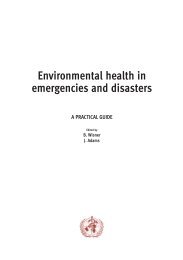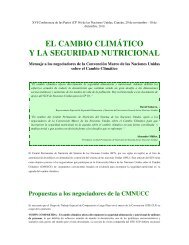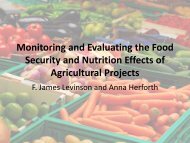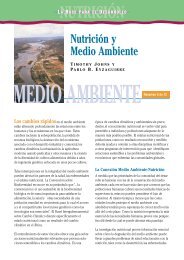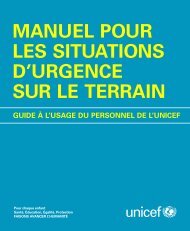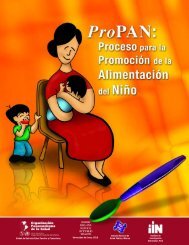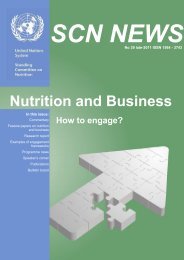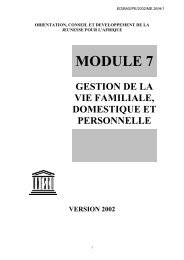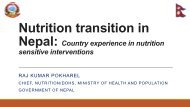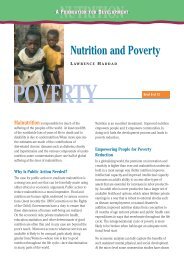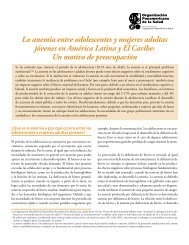SCN News No 36 - UNSCN
SCN News No 36 - UNSCN
SCN News No 36 - UNSCN
Create successful ePaper yourself
Turn your PDF publications into a flip-book with our unique Google optimized e-Paper software.
54<br />
35 TH <strong>SCN</strong> SESSION RECOMMENDATIONS www.unsystem.org/scn<br />
NOTES:<br />
The purpose of these notes is to provide access to programme and policy guidance of relevance to the recommendations<br />
from the <strong>SCN</strong> 35 th Session. The Lancet Nutrition Series (LNS) Paper 5 cites the lack of clear programme guidance as one<br />
of the shortcomings of the international nutrition system. The LNS provides little or no links to the programme guidance<br />
that is available, but then the LNS is much more about the "what" and the "why" of improving maternal and child undernutrition,<br />
and less about the "how". These notes aim to inform national level actors in this regard, so that they are better<br />
able to better interpret and use the recommendations and to help establish successful nutrition programmes that will contribute<br />
to accelerating the reduction of maternal and child undernutrition. These notes recognize that there are various existing<br />
sources of programme guidance in nutrition, but there is no “one stop” place where national level actors can find<br />
such guidance that is still up-to-date. 39<br />
The links can be accessed in the online <strong>SCN</strong> <strong>News</strong> <strong>36</strong>, at www.unsystem.org/<strong>SCN</strong>/Publications/html/scnnews.html<br />
and the full URLs are written out in the 35 th <strong>SCN</strong> Session Recommendations on the <strong>SCN</strong> website at<br />
www.unsystem.org/<strong>SCN</strong>/Publications/AnnualMeeting/<strong>SCN</strong>35/35th_Session_Recommendations.pdf<br />
___________________________________________<br />
1. The Lancet Nutrition Series (LNS) is a series of five articles published in the first few months of 2008. Links to each of the articles<br />
are available online and an executive summary in English and in French is available online.<br />
2. Art. 11 of the International Covenant on Economic, Social and Cultural Rights (ICESCR) defines the right to food as “the right of everyone<br />
to adequate food and to be free from hunger". The ICESCR, which entered into force in 1976, is available online. The normative content<br />
of the right to adequate food is elaborated in General Comment 12 (GC12) to the ICESCR from 1999 (online). See also the Voluntary<br />
Guidelines to support the progressive realization of the right to adequate food in the context of national food security, adopted by the 127th Session of<br />
the FAO Council, <strong>No</strong>vember 2004, which provides practical guidance (online).<br />
3. ICESCR Art. 12 defines the right to health as “the right of everyone to the enjoyment of the highest attainable standard of physical<br />
and mental health” (online). The normative content of the right to health is described in GC14 to the ICESCR from 2000 (online).<br />
4. All human rights are universal, indivisible, interrelated and interdependent. Besides the rights to food and to health described above,<br />
the rights of particular relevance to nutrition include children's right to food, health, care as well as survival and development as defined<br />
in Arts. 24 and 6 of the Convention on the Rights of the Child (CRC) (online). The CRC entered into force in 1991 and enjoys almost universal<br />
ratification by virtually all nation states. Of particular importance to maternal and child undernutrition are the right of mothers to<br />
appropriate services in connection with pregnancy, confinement and the post-natal period, granting free services where necessary, as<br />
well as adequate nutrition during pregnancy and lactation, as defined in Art. 12.2 of the Convention on the Elimination of all forms of Discrimination<br />
Against Women (CEDAW), which entered into force in 1990 (online), as well as the right to work, social security, women's rights,<br />
etc, see further in the Voluntary Guidelines referenced in note 2.<br />
5. United Nations (2000) United Nations Millennium Declaration. Resolution adopted by the General Assembly [without reference to a<br />
Main Committee (A/55/L.2)]. 55/2. (online).<br />
6. United Nations (2000) The Millennium Development Goals (online).<br />
7. Paper two in the LNS concludes that half of the stunting at two years of age is caused by poor growth in uterus and half is due to<br />
poor growth in the first two years of life. The conclusions are based on evidence from cohort studies following the health, growth and<br />
development of children across their life cycle. Victora CG, Adair L, Fall C et al., for the Maternal and Child Undernutrition Study<br />
Group (2008) Maternal and child undernutrition: consequences for adult health and human capital. Lancet 371:340-357.<br />
8. Shrimpton R, Victora CG, de Onis M, et al. (2001) Worldwide Timing of Growth Faltering: Implications for Nutritional Interventions.<br />
Pediatrics 107(5), e75.<br />
9. The LNS only considered evidence for facility based treatment of severe acute malnutrition, even though international guidance is<br />
already promoting the use of community based treatment using RUTFs in conjunction with facility based treatment. A Joint Statement on<br />
the community based management of severe acute malnutrition made by WHO, WFP, <strong>SCN</strong> and UNICEF is available online. The statement<br />
largely draws on the conclusions from an informal consultation as described in the <strong>SCN</strong> Nutrition Policy Paper 21(online).<br />
10. Many nutrition programmes rely on weight growth monitoring as a platform for both providing appropriate guidance as well as<br />
monitoring impact. Weight growth monitoring on its own is not enough however, and certainly beyond two years of age weight and<br />
height must be measured in order to ensure that weight growth is adequate in relation to height. With the development of the new<br />
WHO growth standards, up-to-date programme guidance is available on how to measure and interpret children's growth. WHO (2006)<br />
Training Course on Child Growth Assessment. Version 1. WHO:Geneva (online)<br />
11. Paper three of the LNS lists a set of “core” interventions, for which it considers there is sufficient evidence for implementation in<br />
all <strong>36</strong> countries that are home to 90% of stunted children in the world. Further interventions (“non-core”) are indicated for use in<br />
"specific situational contexts". Bhutta ZA, Ahmed T, Black RE, et al, for the Maternal and Child Undernutrition Study Group (2008)<br />
What works? Interventions for maternal and child undernutrition and survival. Lancet 371( 9610):417-440.<br />
12. Guidance on the feeding of infants and young children is available from the WHO/UNICEF Global Strategy for Infant and Young Child<br />
Feeding from 2003 (online). Two further guidelines to support the implementation of the strategy are also available at the same website:<br />
the WHO Infant and young child feeding: A tool for assessing national practices, policies and programmes from 2003 and the WHO Planning guide for<br />
national implementation of the global strategy for infant and young child feeding (Working draft) from 2006. An integrated course for training health<br />
workers in Infant and Young Child Feeding Counseling is also available online. An important dimension to the infant feeding guidance concerns<br />
the marketing of breastmilk substitutes, on which guidance was first issued over 25 years ago in the WHO International Code of Marketing<br />
of Breastmilk Substitutes from 1981 (online). The Code has been the subject of many subsequent resolutions by the World Health<br />
Assembly, an overview with full text of all these are available online from the International Baby Food Action Network (www.ibfan.org)




